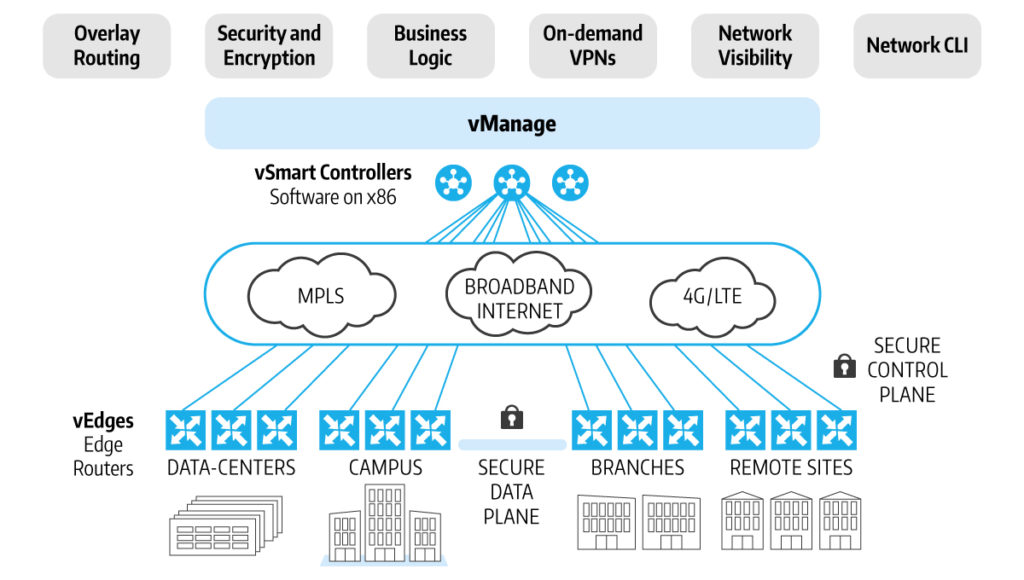Software-defined wide area networking (SD-WAN) is the next big thing since cloud. Every enterprise is talking about SD-WAN to optimize and manage expensive WAN circuits. I recently attended a couple of sessions at Cisco Live on SD-WAN technology (Viptela). There are many different WAN connectivity solutions available today. SD-WAN lets businesses leverage these solutions and optimize WAN circuits, depending on the needs of your users and applications. It is the application-aware routing aspect of the solution that impressed me. We all know that traditional routing protocols (e.g., EIGRP, BGP, and OSPF) are incapable of providing service or application routing, like traditional GPS systems versus Google Maps. Conventional GPS systems are unaware of real-time traffic and road conditions. On the other hand, Google Maps provides you with real-time options and selects the best path to your destination. This same concept is used in application-aware routing—enabling administrators to set parameters and threshold values based on the requirement of application and user experience.
Traditional routing protocols lack the ability to interact with applications. With SD-WAN, applications and the transport infrastructure work alone. The transport infrastructure does not know what type of applications are being transported, and can therefore have a major impact on service level agreements.
This interaction between applications and the underlying transport network infrastructure is increasingly important to service providers, content providers, and large-scale enterprises. With the rise in interactions between application and transport network infrastructures, an optimized network and new services can generate additional revenue and an enhanced end-user experience.
Related: The 5 Networking Trends Small and Medium Businesses Can’t Afford to Miss in 2020
MPLS Traffic Engineering Essentials
Multiprotocol label switching (MPLS) is the preferred mode of WAN connectivity for many organizations. However, there are some drawbacks. MPLS traffic engineering can curtail network blockage and boost performance, but it is not easy to configure or maintain due to the constant changes in application flows, increased bandwidth requirements, Internet of Things, and cloud services. Additonally, application flow control in the WAN is not sufficient to deliver an optimal end-user experience over a single transport. End-to-end control is now required over hybrid WAN models (i.e., MPLS, WAN, and the Internet).
SD-WAN Simplified
The ultimate goal for SD-WAN and segment routing is to provide businesses with different levels of transport and service level agreements. Cisco’s Viptela SD-WAN is the answer, bringing application and network interaction to the next level in the SDN era.
You can build a better, more agile network using these Cisco SD-WAN architecture layers:
- Infrastructure—Acts as the foundation for an SD-WAN architecture, with both physical and virtual network devices
- Controller—Provides a single, centralized view of the entire WAN network
- Application—Consists of network services, orchestration tools, and business applications that interact with the control layer
Viptela SD-WAN Architecture

Doing SD-WAN Right
Load balancing traffic over multiple WAN links is not a new capability, and also not an easy task. Without the full support of static IPs, your SD-WAN solution essentially becomes a one-way solution. But Cisco’s Vitela SD-WAN simplifies load balancing. With this solution, WAN link functionality can dynamically load balance traffic over both MPLS and Internet links—and reduce the cost of both.
Along with SD-WAN, implementing policies at the application, network, or site level can also help you manage complex environments as well as user relationships, services, SLAs, and device-level performance metrics.
Communication often lags in traditional network designs. SD-WAN offers a more efficient solution for your enterprise network. With a unified view of your network topology, SD-WAN makes life easier with a few simple clicks.
For more information about SD-WAN, contact a Connection Networking Expert today.

